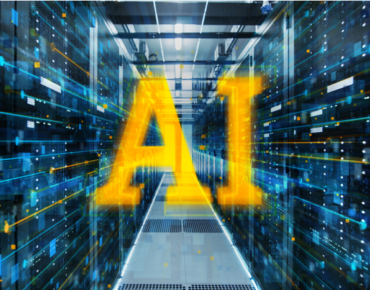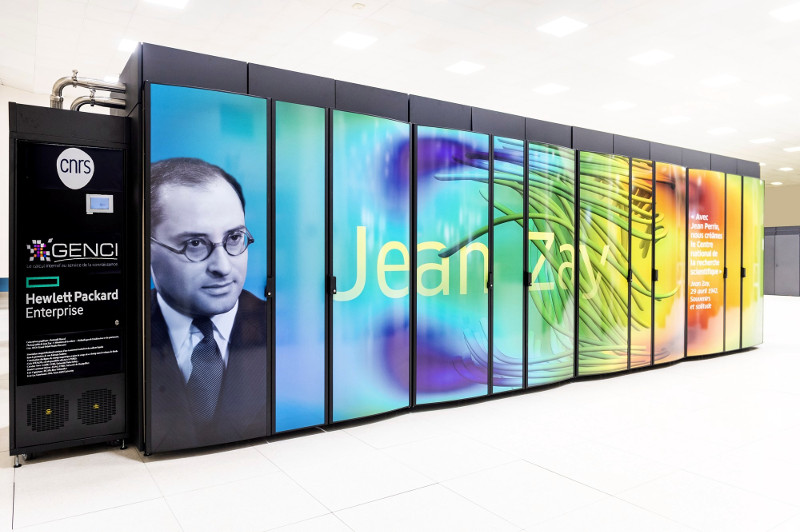France’s Jean Zay Supercomputer Getting a Major Nvidia A100 Power Boost for AI Research

Since coming online in the fall of 2019 in Paris, the Jean Zay supercomputer has been one of Europe’s most powerful supercomputers available to HPC and AI researchers.
And now, through the addition of new Nvidia A100 80GB GPUs and other hardware, the Jean Zay will soon offer double its present compute capacity for AI and HPC research, according to GENCI (Grand Equipment National de Calcul Intensif), which is the French national agency in charge of high performance computing and storage resources for academic research and industry.
The power boost will come from an additional 52 nodes made up of Apollo 6500 Gen10 nodes, each with eight Nvidia A100 80GB GPUs – for a total of 640GB of high-bandwidth memory (HBM2) per server – and some minor additional updates that include three Apollo 6500 Gen10 nodes, each with eight Nvidia A100 40GB PCIe GPUs, Stephane Requena, the director of innovation and technology at GENCI, told EnterpriseAI.
The updated Jean Zay supercomputer will then feature a total of 3,152 GPUs when it is completed by the end of this year.
“This will double the computing capacity available for AI research in this converged HPC and AI system,” said Requena.
The upgrades for the Jean Zay were unveiled Nov. 17 (Wednesday) at the SC21 conference, which was a hybrid event in-person in St. Louis, Missouri, and virtually. Also involved in the Jean Zay upgrade project is the French National Centre for Scientific Research (CNRS) and its Institute for Development and Resources in Scientific Computing division (IDRIS), as well as Hewlett Packard Enterprise (HPE), which built the original Jean Zay, and Nvidia. The Jean Zay is in Paris at IDRIS.
“One of the first AI projects to use this extension full-time will be the ‘Big Science’ project, which is aiming to develop an open, multi-lingual and ethical Natural Language Processing (NLP) model of up to 200 billion parameters, competing with OpenAI’s GPT-3,” said Requena. “This project is gathering more than 600 partners worldwide from academia and industry, including startups, small- and medium-sized enterprises, and other large groups). It is seen as the CERN of NLP.”
So far, more than 700 AI projects have been using the Jean Zay machine since it became available, he said. “With the announcement of the second phase of the French AI plan, called AI For Humanity, our Jean Zay system will continue to serve AI French research with sovereign facilities and provide tailored user support.”
Bringing In Deeper Research Capabilities
The power boost for the machine is significant for the agencies behind it, said Requena. “It proves that Jean Zay, a pilot of converged systems, succeeded in serving beyond traditional HPC user communities … in all domains, and accelerating simulation and AI joint projects. This extension will allow us to foster this dynamic and will allow us to drive large-scale AI projects in public-funded infrastructures.”
The research conducted using Jean Zay so far includes automatic language processing, computer vision, decision support, smart cities research, health and medicine including the fight against COVID-19 and cancer, as well as neurosciences, robotics, social sciences, chemistry, particle physics, astrophysics and climatology, he said.
![]() IDRIS has bolstered its application support team to meet the extra demand by bringing in nine more support staffers, bringing the number of support workers to 21.
IDRIS has bolstered its application support team to meet the extra demand by bringing in nine more support staffers, bringing the number of support workers to 21.
The Nvidia A100 80GB GPUs that are being added to Jean Zay include third-generation Tensor Cores, which provide up to 20x the AI throughput of the previous Volta generation with a new format TF32, as well as 2.5x FP64 for HPC, 20x INT8 for AI inference and support for the BF16 data format. Also included is faster HBM2e (high-bandwidth memory) with more than two terabytes per second of memory bandwidth, and Nvidia MIG (multi-instance GPU) technology that doubles the memory per isolated instance, providing up to seven MIGs with 10 gigabytes each. Third-generation NVLink and NVSwitch capabilities are also included, which provides twice the GPU-to-GPU bandwidth of the previous generation interconnect technology and accelerating data transfers to the GPU for data-intensive workloads to 600 gigabytes per second.
All this additional compute power will be a major asset for the development of AI in France and in Europe, said Requena “The deployment of this new computing capacity will allow the development of innovative research projects, even unprecedented [projects], on a global scale.”
Also planned is an innovative system set up by IDRIS and the Paris-Saclay Public Planning Establishment (EPAPS), which will allow the large amount of heat produced by the Jean Zay supercomputer to used elsewhere, said Requena. The heat from the supercomputer will supply the network of heat and cold exchangers at the Paris-Saclay Urban Campus, providing thermal coverage for the equivalent of 1,000 housing units. That aspect of the project will be a first in Europe, he said.
The supercomputer upgrade project is being funded by the French Ministry of Higher Education, Research and Innovation and is the joint work between GENCI, IDRIS-CNRS, HPE and Nvidia.
Project History
HPE won the contract to build Jean Zay in 2019. The system is named Jean Zay for a French Minister of National Education and Fine Arts who served from June 1936 to September 1939. As education minister, Jean Zay implemented important advancements in the French educational system and as the fine arts minister, he initiated the creation of the Musée d'Art Moderne, the Musée de l'Homme, the Musée des Arts et Traditions Populaires and the Cannes Film Festival. He also contributed to the creation of France's National Centre for Scientific Research (CNRS) in 1939. He was assassinated on June 20, 1944, by the Vichy militia. The CNRS named it in his honor to pay tribute to his contributions to France.
The original as-built configuration of the Jean Zay machine had a peak performance of 14 petaflops (14 million billion floating point operations per second).
Jean Zay began as an HPE SGI 8600 computer which is partitioned into two sections. The first section is composed of scalar nodes and the second section of converged accelerated hybrid nodes. These hybrid nodes include CPUs and GPUs to allow them to run effective HPC and AI workloads. All the compute nodes are interconnected by an Intel Omni-Path network and access a shared file system with high bandwidth. The original machine included 1,528 XA730i compute nodes, with two Intel Cascade Lake 6248 processors (20 cores at 2.5 GHz), or 40 cores per node and 261 XA780i converged nodes, with two Intel Cascade Lake 6248 processors and four Nvidia V100 SXM2 GPUs (32GB each).
Analyst Reactions
Karl Freund, founder and principal analyst at Cambrian AI Research, said the upgrades for the French supercomputer are a reality today for supercomputer owners.
“AI is no longer an option for most HPC users and scientists,” said Freund. “Adding the Nvidia A100s to the existing V100 GPUs bring Jean Zay to the forefront of using AI to estimate simulation results at dramatically lower cost and faster turnaround.”
Another analyst, Dan Olds, the chief research officer at Intersect360 Research, called the update plans interesting and said the moves “point to the burgeoning world of AI that they have this kind of demand to build out a box that big.”
Olds said the upgrades are a good result for HPE and Nvidia as well.
“I would point out that these deals are going to become more competitive with the advent of AMD GPU and processor announcements and what Intel has coming down the road,” said Olds.
Also intriguing, he said, is the move to use the supercomputer’s waste heat to warm buildings. “That is pretty innovative,” said Olds. “We are going to see more of that in the future.”
In related news at SC21 earlier this week, HPE was named to build France’s latest supercomputer, named Adastra, a 70 peak petaflops machine that will be owned by GENCI and the country’s National Computing Center for Higher Education, (CINES). The system, slated for delivery and operation next year, will support French academic and industrial research.














